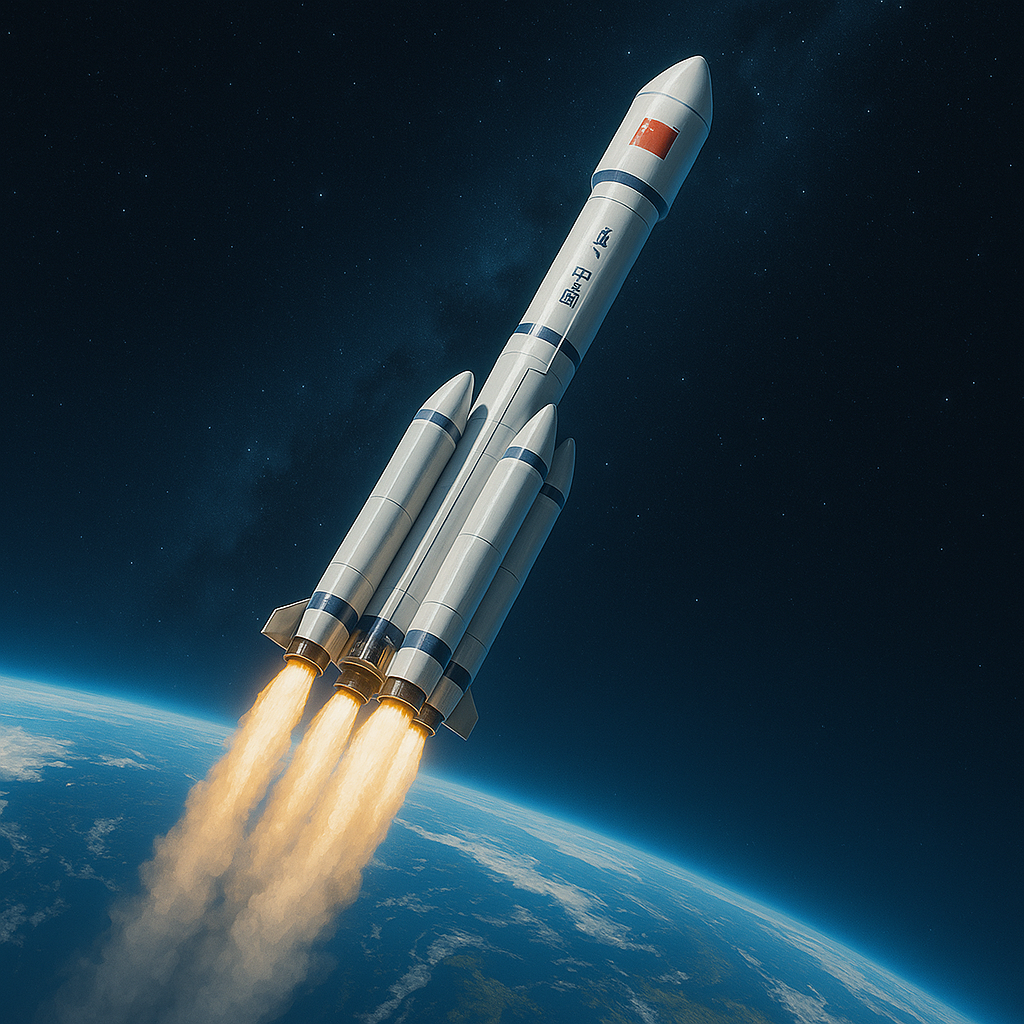By Krzysztof Karwowski (PSJ Editorial Team, SGH Warsaw School of Economics)
China has been intensively developing advanced technologies for the past two decades and is also conducting an active space program. On Thursday, May 28, a new chapter is set to begin with the launch of the Tianwen-2 space probe. This research mission—developed under the working name „Zheng He Mission”—aims to explore asteroids and comets, expanding our understanding of non-planetary objects in the Solar System. It seeks to build on the achievements of Japan’s Hayabusa missions and NASA’s OSIRIS-Rex [1]. The probe’s targets include the asteroid Kamoʻoalewa and the comet 311P/PanSTARRS, which will be studied using magnetic detection instruments, multispectral cameras, and interferometers provided by the Chinese Academy of Sciences. Additionally, the probe is expected to attempt a landing on Kamoʻoalewa, collect surface samples, and return them to Earth. China has already tested sample-return technologies in its Chang’e program, which explored the Moon [2].
Where does China’s fascination with space originate, and what is the history of its space program? You will find out in this article.
Historical Context
Over the past decades, China has transformed from a developing country into a global leader in technology, economy, and military power. This shift coincided with the maturation of rocket technology, which Beijing identified as a key driver of national development. Although China launched its first satellite in 1970 under the secretive „Two Bombs and a Satellite” program, it was only after the collapse of the USSR in 1991—and access to Russian expertise—that its space ambitions gained real momentum. Since then, China has pursued space exploration as a pillar of innovation policy, embedded in its broader strategic planning through 5- and 10-year national programs [3-4].
Initially, a family of efficient and reliable launch systems – Long March rockets – was created, which have been practically tested in every currently prepared scenario of a space mission. Since 1970, when a modified military ballistic missile was launched as Long March 1, almost 20 versions of space rockets have been successfully deployed and carried out orbital flights. Each of them was designed for a different task, payload, and specification [5-6]. The next of development was the performance of a safe manned mission. In this case, the Chinese surprised the world in 2003. Currently, Chinese crewed flights have become routine, and starting from 2020, when China launched Tiangong (Heavenly Palace) orbital station, the presence of taikonauts in orbit has become permanent [6, 17].
Space Missions and Key Projects
The success of the Long March rocket system and the Shenzhou manned capsules has prompted the PRC to seek further milestones previously achieved by the USA and the USSR/Russia in the development of space capabilities. From an economic perspective, the most significant importance currently lies in the Beidou global satellite navigation system, carried out in three phases since the late 20th century and grandly completed in 2018. This system, analogous to the American GPS or the European Galileo, is available worldwide for free (excluding the cost of the receiving device). In the first phase (since 2000), it test-covered the territory of China serviced by four prototype satellites. In the second phase, testing began in 2007, and the navigation network was spread over almost entire Asia (Beidou 2). The third phase of construction (2015-2018) enabled global functioning with 30 modern Beidou 3 satellites. This system constitutes an important component of China’s strategic infrastructure—the Strategic Rocket Forces of the People’s Liberation Army use it for navigation purposes for the nuclear triad. It also symbolizes technological progress, making China less dependent on the US for critical services [6-8].
As shown by media discourse, China’s space conquest is inseparably connected narratively and scientifically with native tradition and symbolism. For this not the only but prominently exposed reason, China is intensely interested in Moon. The Chinese Lunar Exploration Program is named after the goddess Chang’e. Conducted since 2004, its progress has been strongly emphasized in foreign media. So far, China has achieved all its set goals in lunar exploration: orbiting and circumlunar research, landing on the Moon’s surface and rover operations, landing on the far side of the Moon and successfully communicating from there (Chang’e 4 mission in 2019—particularly significant as no country previously landed on the far side due to the lack of communication ability. China solved this problem using a relay communication method via the Queqiao satellite). Since 2021, all Chang’e missions have been subordinated to the International Lunar Research Station project, endorsed by China, which, in multilateral cooperation, plans to build a permanent research facility near one of the Moon’s poles after 2030. The base, following the model of space stations, is intended to provide a permanent human presence on the Moon and the opportunity to deepen scientific research, especially geological measurements related to lunar resources [9-11].
The last discussed endeavour is Tianwen (Heavenly Question), a series of space missions dedicated to the study of planets and other bodies in the Solar System. The flagship Tianwen 1 mission to Mars has been realized so far, which is currently operated by three devices: an orbiter, a lander, and the rover Zhurong delivered by it. Further missions are in the conceptual phase, including studies of the Asteroid Belt (confirmed as Tianwen 2), Venus, the moons of Jupiter, and a sample return mission from Mars analogic to lunar missions (Mars Sample Return). It is worth paying attention to ideas and information regarding the latter idea due to China’s bold declarations about intending to send a manned mission to Mars [12-14].
Conclusions
The official budget of the program was estimated at $8.9 billion in 2020; $11.9 billion in 2022. Therefore, we can expect a continuation of expenditure growth, as well as further, increasingly ambitious space missions. As for China’s global ambitions, the space program can be interpreted as a symbol of promoting the Chinese development model in the global South. Prestige and strategic capabilities, on the other hand, are important as support for China’s idea of global leadership, its course of transforming the economy into an innovative and green way, and the emphasis on territorial integrity and unity in an increasingly stratified society [15]. A significant international fact remains China’s invitation to Russia to participate in the ILRS lunar station program. It confirms the technical and political contacts of the Russian ROSKOSMOS agency with Beijing, but in a completely different form than during the Soviet era. Rapidly enriching China is beginning to play the role of the dominant partner for the underfunded and sanction-limited Russian program, and many still unique Russian technical solutions will be taken over by China in the future [16-17].
Sources:
[1] ZHAO Z., QUAN Q., PAN B., WEI Q. & ZHAO J. (2021). 多臂协作式小天体附着取样机器人机械系统. 哈尔滨工业大学学报, 54(1), 1–8. https://doi.org/10.11918/202101109
[2] Zhang, X., Huang, J., Wang, T. & Huo, Z. (2019). ZhengHe – A Mission to a Near-Earth Asteroid and a Main Belt Comet (PDF). 50th Lunar and Planetary Science Conference. Retrieved 26.05.2025 from https://www.hou.usra.edu/meetings/lpsc2019/pdf/1045.pdf
[3] Góralczyk, B. (2022). Nowy długi marsz: Chiny ery Xi Jinpinga (Ed. II). Dialog Press.
[4] Karwowski, K. Visvizi, A., Troisi, O. (2023). „Explaining China’s pivots and priorities through the aerospace industry development strategy”. In: Visvizi A., Troisi, O. & Corvello, V. (eds) Research and Innovation Forum 2023. Navigating Shocks and Crises in Uncertain Times—Technology, Business, Society. DOI: 10.1007/978-3-031-44721-1_41
[5] Karwowski, K. (2025). Chiny: Od papierowych rakiet do podboju kosmosu. Układ Sił, https://ukladsil.pl/wyscig-technologiczny/chiny-od-papierowych-rakiet-do-podboju-kosmosu, access: 26.05.2025
[6] Woodrow Wilson International Center for Scholars. Chinese Nuclear History, https://digitalarchive.wilsoncenter.org/collection/105/chinesenuclear-history, access: 26.05.2025
[7] Karwowski, K. (2024). „The Competition Among Stars: Case Studies of American-Russian-Chinese Rivalry in Space Exploration”. In Pietrzak, P. [Ed.] Dealing With Regional Conflicts of Global Importance (Chapter 16) pp. 314-330. IGI Global Publishing, Hershey PA 2024, doi 10.4018/978-1-6684-9467-7.ch016
[8] Huang, H. & Arranz, A. (2020) China’s Global Navigation System, SCMP, https://multimedia.scmp.com/infographics/news/china/article/3098087/beidou-satellite/index.html?src=article-launcher, access: 26.05.2025
[9] Harvey B. (2004). China’s Space Programme: From Conception to Manned Space Flight. Praxis Publishing Chichester.
[10] Lu, Y. (2021), Progress and International Cooperation China Manned Space Program, CMSP Overview 2021-8
[11] ILRS Guide for Partnership, China National Space Administration, https://www.cnsa.gov.cn/english/n6465652/n6465653/c6812150/content.html, access: 26.05.2025
[12] Jones, A. (2020) Tianwen-1 launches for Mars, marking dawn of Chinese interplanetary exploration, Space News, https://spacenews.com/tianwen-1-launches-for-mars-marking-dawn-of-chinese-interplanetary-exploration/, access: 26.05.2025
[13] China plans its first Mars crew mission to Mars, Reuters, https://www.reuters.com/business/aerospace-defense/china-plans-its-first-crewed-mission-mars-2033-2021-06-24/, access: 26.05.2025
[14] Tiwari, S. (2022) Beating NASA, China Set To Become 1st Country To Get Martian Sample Back On Earth, Euroasian Times, https://www.eurasiantimes.com/martian-samples-china-set-to-beat-nasa-esa-to-get-mars-soil/, access: 26.05.2025
[15] Kenderdine, T. (2017). China’s industrial policy, strategic emerging industries and space law: China’s industrial policy. Asia & the Pacific Policy Studies, 4(2), 325–342. https://doi.org/10.1002/app5.177
[16] Ng, T., China-US space race heats up as Chinese firm plans over 40 launches this year, SCMP: https://www.scmp.com/news/china/military/article/3162196/china-us-space-race-heats-chinese-firmplans-over-40-launches, access: 26.05.2025
[17] Karwowski, K. (2024). Ze smokiem do gwiazd. Chiński program kosmiczny. INE, https://ine.org.pl/chinski-program-kosmiczny/, access: 26.05.2025


